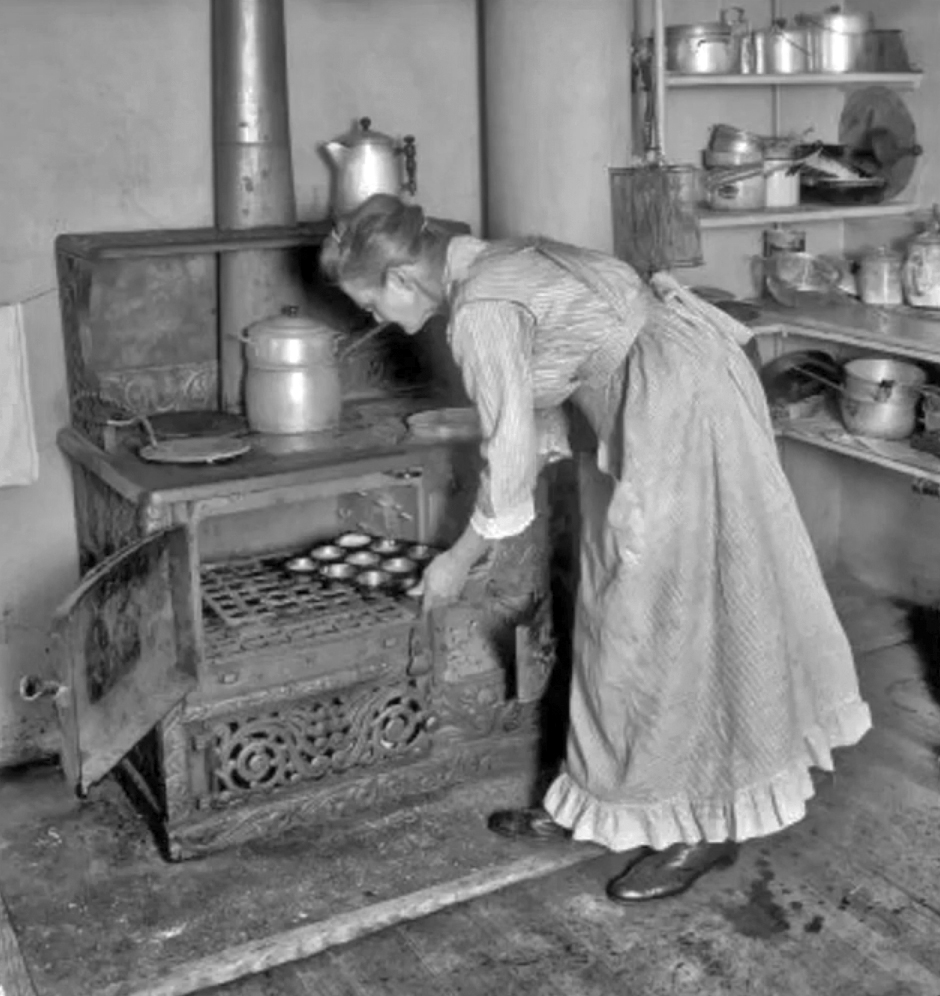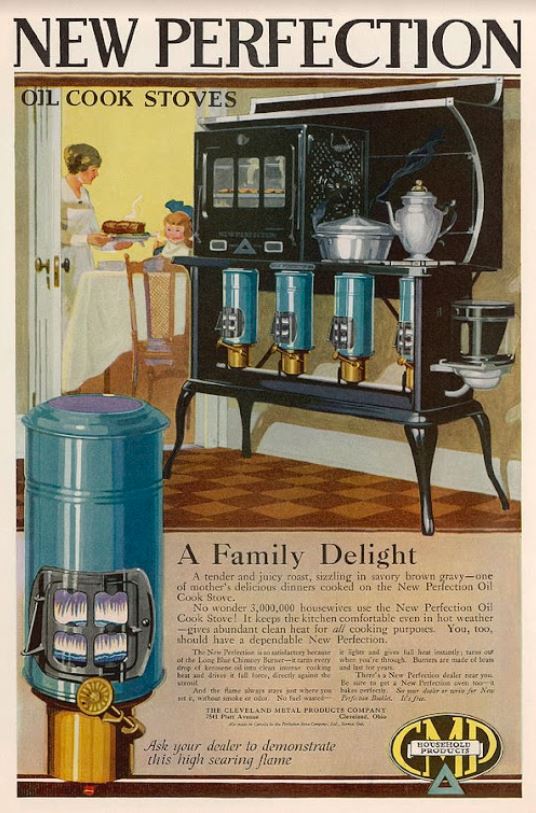“New Perfection” kerosene stoves once competed with coal and wood-burning stoves in rural kitchens.
In the early 1900s, a foundry in Cleveland, Ohio, began manufacturing and selling an alternative to coal or wood-burning cast iron stoves. Thanks to a marketing partnership with Standard Oil Company, millions of rural kitchens would cook with kerosene-burning stoves.
America’s energy future changed after 1859 when a new “coal oil” (kerosene) was refined from petroleum purposefully extracted from wells drilled near Oil Creek, Pennsylvania.

A Cleveland foundry president in 1901 approached John D. Rockefeller about a new, kerosene-fueled alternative to cast iron home stoves like this one.
The improved and inexpensive lamp fuel would soon replace dangerous burning fluids, including volatile camphene. The new “Oil Region” of northwestern Pennsylvania became overrun with drilling as “black gold” oilfield discoveries marked the birth of a chaotic exploration and production industry.
After decades of fierce competition, John D. Rockefeller emerged and brought stability to petroleum markets — often at the expense of independent producers. By the turn of the 20th century, Rockefeller’s Standard Oil empire controlled more than 90 percent of all the petroleum produced, refined and sold in the United States.

An advertisement by Standard Oil Company of New York (Socony) promoted the company’s kerosene-fueled “New Perfection Oil Cookware.”
Kerosene, a future rocket fuel, quickly became the nation’s preferred illuminant and Standard Oil’s principal product. Rockefeller’s business practices made enemies but reduced the cost of kerosene for millions of consumers.
America’s first automobile show in November 1900 barely hinted that demand for “gasolene” might someday exceed that of kerosene. Gasoline at that time was just a low-value by-product of kerosene refining. In 1917, U.S. refineries produced more gasoline than kerosene for the first time as auto registrations reached almost 5 million (with another 400,000 commercial, agricultural, and military vehicles).
Standard Oil’s kerosene sales also eroded because of Thomas Edison’s incandescent bulbs with George Westinghouse’s alternating current illuminating more homes. For electric companies, economies of scale were to be found in metropolitan markets where kerosene was already being challenged by manufactured gas — “Town Gas.”
No business case could be made for profitably delivering electricity to rural America. Farmers continued to rely on kerosene along with other Standard Oil petroleum products. An Ohio entrepreneur then came up with an innovative alternative to cast iron stoves.
Standard Oil’s Kerosene Network
In 1901, Francis E. Drury, owner of the Cleveland Foundry Company, approached John D. Rockefeller with a partnership proposal. Drury’s plan would get Standard Oil into the business of selling his company’s alternative to the wood or coal-burning cast iron stove — a kitchen stove fueled with kerosene.

Thanks to early marketing help from 300 Standard Oil salesmen, a foundry in Cleveland, Ohio, manufactured millions of “Perfection” stoves that burned kerosene.
A few years earlier, Drury and partner Henry Parsons Crowell had explored the idea of a “lamp stove,” according to History of the Perfection Stove Company. “The two men discussed the practicability of such an item. A patent was applied for; the Cleveland Foundry Company began building and then selling the stove. The ‘Perfection Stove Company’ was born.”
Drury wanted to change the old ways in the kitchen and the burdensome chores. He looked for “anything which will save the carrying up of coal, the carrying down of ashes, the noise and dust and dirt and odor and heat and hard labor and time consumed in attending to fires.”
Drury believed that in unelectrified rural America, kerosene stoves would find many receptive customers, adding company’s invention would “do nothing short of revolutionizing the domestic life of the day.”
Since Standard Oil already served remote users with established kerosene-wagon delivery routes, every stop offered a potential point of sale for the new stove. With this far-reaching distribution system, 300 company salesmen pitched the new “Perfection” branded stoves.
The sales representatives urged replacing old iron stoves with the kerosene stove’s amazing advantages, including hours of labor savings and “emancipation from overheated kitchen drudgery in hot weather.”
Standard Oil promoted using its Pearl Oil kerosene “for the best results” in the Perfection stove. “Pearl Oil, the Standard Oil Company’s kerosene,” noted one advertisement, “a most convenient and economical fuel — without the dust and dirt of coal or wood.”

Cleveland Metal Products Company, which evolved from Drury’s earlier foundry, manufactured and sold the New Perfection Oil Cook Stove. By 1922, more than 3 million Perfection kitchen stoves were used in U.S. homes.
The Cleveland Metal Products Company manufactured its New Perfection Oil Cook Stoves as the ideal replacement for coal-burning stoves. The appliance used circular burners with easily maintained special wicks (see a sample user’s manual).
“A Family Delight,” noted a Cleveland Metal Products advertisement that also encouraged readers, “Ask your dealer to demonstrate this high searing flame.”
By 1915, the Drury-Rockefeller partnership had sold millions of kerosene-burning stoves. Five years later, the number of gasoline-hungry vehicles on America’s mostly unpaved roadways reached almost nine million. Standard Oil’s response to increasing demand for gasoline prompted an amicable dissolution of the partnership.
Although Rockefeller’s business dealings brought controversy, the oil tycoon’s Standard Oil, “gave us time to build up a salesman organization,” Drury noted. “Through all our experiences with the Standard Oil Company acting as our distributors, our relations have been most cordial and profitable,” he explained in his autobiography.
The Cleveland Foundry, which also made kerosene-fueled heaters, in 1917 merged with Cleveland Metal Products Company and used that name before becoming Perfection Stove Company a few years later. By 1922, Drury’s company reached cumulative sales of more than 8 million kerosene-burning stoves, heaters, and ranges.
Thanks to the Standard Oil kerosene network and the innovative stove, Drury became a very wealthy Ohio businessman. He built a mansion on Cleveland’s fashionable Euclid Avenue, down the street from Rockefeller. The kerosene stove entrepreneur died in 1932, three years before President Roosevelt’s New Deal established the Rural Electrification Administration, which would electrify half of America by 1940.
Lehman’s of Kidron, Ohio, in 2025 offered its Amish-made Perfection Kerosene Cookstove With Oven, “designed to handle daily cooking for large Amish families” for $3,189, including brass burners with seamless ceramic chimneys, thick porcelain coatings, and a steel, one-gallon tank for the kerosene.
_______________________
Recommended Reading: Oil Lamps The Kerosene Era In North America (1978); Myth, Legend, Reality: Edwin Laurentine Drake and the Early Oil Industry
(2009). Your Amazon purchase benefits the American Oil & Gas Historical Society. As an Amazon Associate, AOGHS earns a commission from qualifying purchases.
_______________________
The American Oil & Gas Historical Society preserves U.S. petroleum history. Please become an AOGHS annual supporter and help maintain this energy education website and expand historical research. For more information, contact bawells@aoghs.org. Copyright © 2025 Bruce A. Wells. All rights reserved.
Citation Information – Article Title: “Standard Oil and Kerosene Stoves.” Authors: B.A. Wells and K.L. Wells. Website Name: American Oil & Gas Historical Society. URL: https://aoghs.org/products/standard-oil-and-the-kerosene-stove/. Last Updated: January 17, 2025. Original Published Date: January 23, 2023.



